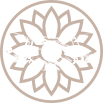Scenic Spots
Gate Tower of the Presidential Palace
The Taiping Heavenly Kingdom erected the Heavenly Kingdom Palace on the premises of the outer gate of the Office of Liangjiang Governor in the Qing Dynasty. The gate of the Palace was called “Zhen Shen Rong Guang Men”(Genius Gate).After the Manchu Troop’s recovery of the Heavenly Capital in 1864,it was demolished, and the outer gate of the Office of Liangjiang Governor was rebuilt. The present Western-style reinforced concrete gate tower was built by the National Government in 1929. Chiang Kai-shek was elected president and organized a presidential Government in May 1948, and the president gate tower was then renamed the gate of the Presidential Palace.
Eastern Waiting Rooms
As Qing Dynasty buildings, they served as the rooms of the Personnel, Revenue, and Rites of the Office of Liangjiang General during the Qing Dynasty. Then, they became waiting rooms for the officials to pay respects to the Heavenly King Hong Xiuquan during the Taiping Heavenly Kingdom. Later, they were also used as the living quarters of the guards regiment (brigade) of the Presidential Palace during the National Government.
Western Waiting Rooms
As Qing Dynasty buildings, they served as the rooms of the Personnel, Revenue, and Rites of the Office of Liangjiang General during the Qing Dynasty.. Then, they became waiting rooms for the officials to pay respect to the Heavenly King Hong Xiuquan during the Taiping Heavenly Kingdom. Later, they were also used as the living quarters of the guards regiment (brigade) of the Presidential Palace during the National Government.
Main Hall
It is the main building of the Presidential Palace. Here was the “Golden Dragon Hall” where Hong Xiuquan held court during the Taiping Heavenly Kingdom. It was burnt down by the Qing army after the fall of Tianjing (Nanjing). The present hall was rebuilt by Zeng Guofan during the reign of the Emperor Tongzhi (1870). After the victory of the Revolution of 1911, Dr. Sun Yat-sen was elected President of the Interim government of the Republic of China. The ceremony was held in here. It became the hall of the National Government after 1927. In order to commemorate this epoch-making event, Dr. Sun Yat-sen wrote four Chinese characters “Tian Xia Wei Gong” (i.e. the Whole World as One Community) on a plaque. Now the plaque with Dr Sun Yat-sen’s inscription is hung on the crossbeam of the Main Hall.
The Auditorium of Presidential Palace
The Auditorium of Presidential Palace used to be a heated room in the main hall of the Office of Liangjiang Governor during the Qing Dynasty. During the Republic of China, the room was used as an auditorium by the interim government.
The auditorium had been redecorated three times, which were in 1929, 1935 and 1946 respectively. Numbers of important meetings and activities were held inside it. For example, Chiang Kai-shek’s presidential inauguration was held in the auditorium on 20th May, 1948.
The Second Hall
This hall was built in the year 1870 (during the reign of the Emperor Tongzhi in the Qing Dynasty). Foreign diplomats were received and they handed in credentials to the president in this hall during the Republic of China. The architectural style of this hall is a mix of Western and Chinese styles. This hall has been redecorated for plenty of times. The inner part of the hall was built in Chinese style, while the porches outside the north wall were built in Western style.
The Reception Hall
This hall was the place where President Chiang Kai-shek and Acting President Li Zongren met their guests. On 1st July 1946, President Chiang received Chou En-lai the head of the Communist Party negotiation delegation here. On 29th March 1949, Acting President Li Zongren received Zhang Zhizhong and discussed about some important matters negotiation. This hall was recovered based on the descriptions in historical records.
The Chinese Unicorn Gate
This gate was originally built for the sake of safety, with a screen door behind it, which was destroyed in the early 1950s, cutting off the path which connects the Main Gate and Zichao Building. There are a pair of stone Chinese Unicorns at each side of the gate.
Zichao building
It was originally the office building of the National Government, It was designed by Yu Binglie, and constructed by Nanjing Chuang Building Company at the total cost of 106952 yuan (silver dollar).
In December 1937, Japanese troops occupied Nanjing, and the building was used by the Japanese army and the puppet government.
After the victory of the Anti-Japanese War, the National Government moved from Chongqing to Nanjing in 1946, and it served successively as the National Government in the presidential office building in May 1948. There were the offices of the National Chairman Lin Sen, President Chiang Kai-shek, Vice President Li Zongren and the secretary-general, as well as a conference hall and so on inside it.
The two cedars on both sides of the building were personally planted by Lin Sen (the Chairman of the National Government). The seeds of the two cedars were introduced from India at very precious prices.
Air-Raid Shelter
Japanese planes often made air attacks on Nanjing after Japanese troops attacked on Shanghai on 28th January1932. Therefore, when the National Government built the office building in 1934, they also erected this air-raid shelter. It was a two-storey reinforced concrete structure. Its roof was several meters thick to protect against heavy bomb. It was well appointed. It was only a dozen meters away from the office building of the National Government, so it is extremely convenient for evacuation. It is used only by officials at or above bureau level of the National Government (the Presidential Palace). In January 1949, prior to the retirement of Chiang Kai-shek from the political arena, the staff of the Presidential Palace burnt a lot of confidential documents in the shelter.
The Presidential Palace Garage
After the National Government was established, it has been used as a garage. Upstairs is the dormitory of guards and drivers. In April 1949 when the People's Liberation Army took over the Presidential Palace, a lot of abandoned luxury cars and stockpiled gasoline were collected from the garage.
The Water Fountain
The water fountain was built in the same time as the Zichao Building. It was designed in western style.
Xuyuan Garden
The Xuyuan Garden was originally the garden at the residence of Zhu Gaoxu in the early Ming Dynasty, and then it became the garden of the Office of Liangjiang Governor in the Qing dynasty. It was damaged by the Qing Imperial Troops and restored by Zeng Guofan.
The interim government of the Republic of China was founded in January 1912. The President Dr. Sun Yat-sen’s Office and Residence were settled here. After the establishment of the National Government in April 1927, the Garden served as the Offices of the Headquarters of the National Revolutionary Army, and the Military Affairs Council of the National Government.
Lunyin Tablet
Lunyin (ie. imperial edict) was a term of speech meaning that any words of the emperor were very important and exert great influence. The term comes from the Book of Rites which was written by Confucius students. It was said that this tablet was erected by Hong Xiuquan the Heavenly King of the Taiping Heavenly Kingdom.
Tongyin (Sound of Rain) Hall
This hall was a Chinese style architecture built in the ninth year of the Qing Emperor Tongzhi (1870). It was called “Tongyin Hall” because you can hear the sound of rain falling on the leaves of the trees when you are in this hall. Zeng Guofan always played chess in the hall. Dr. SunYat-sen also used this hall as a meeting room.
“Fangsheng” (Coupled) Pavilion
It was the ancient pavilion in Xuyuan Garden. As seen from the far distance, there are two pinnacles in the pavilion, which made it seem like there are two pavilions side by side. From the closer aspect, there is only one pavilion with two pinnacles. This kind of pavilion is very rare in the south of the Yangtze River.
Stone Boat (Unmoored Boat)
Stone Boat (Unmoored Boat) was built in the peiod of Emperor Qianlong during the Qing Dynasty on his second inspection tour to the south of the Yangtze River. King of the Heavenly Kingdom Hong Xiuquan and President Dr. Sun Yat-sen always came here to take a rest. The base of the stone boat is made of bluestone and located at the bottom of the lotus pond. The cabin of the stone boat was carved with wood with a simple and elegant shape and covered with black tiles at the top. The four overlapped layers are solid and heavy. Amidst frequent wars in pre-modern times, it was repeatedly destroyed and rebuilt, with only the stone boat base preserved. Therefore, it is the oldest architecture in the Presidential Palace, as well as the only building with the northern official style of the Qing Dynasty in the Xuyuan Garden
The Wang Ting(Yinxinshi Wu Tablet Pavilion)
It was the traditional Chinese style building used as the overlooking tower during the Taiping Heavenly Kingdom. You can see the overall view of the palace from the top of the pavilion. It was destroyed when the Hunan Army occupied the Heavenly Capital and the present building was rebuilt in the late Qing Dynasty. But it lost the function as a overlooking tower due to a great decrease in its height. On the wall of the pavilion, there was a picture and article of Yinxinshi Wu (Seal-shaped Stone House)wrote by Taoshu, the Liangjiang Governor.
“San Duan”(Three Pieces)Tablet
This tablet was carved during the Three Kingdoms Period(A.D.220-280)by Sun Hao, the last emporor of the Kingdom of Wu. Originally called the “Tian Xi Shen Chen”, it was originally erected outside the “Tian Xi” Temple in southern Nanjing. After it was burned, it was re-carved and moved to Jiangning Country School during the reign of the Ming Emperor Jiaqing.
The Xijia (Dusk Beauty) Tower.
The tower was built in the ninth year of the reign of the Qing Emperor Tongzhi(1870).It was called Xijia Tower because it was very beautiful when the setting sun cast a golden glow over the building.
Imperial Tablet Pavilion
Sa Zai, the Liangjiang Governor, was rewarded by the Emperor Qianlong because of his achievements. In 1874, because he failed to note that his subordinate Hao Shuo, the Jiangxi Provincial Governor, was taking bribes, he was removed from the office. His successor, Shu Lin, learned a lesson from Sa Zai’s misfortune when he took office in 1787, so he fight against the corruption. As a result he was praised with the Emperor Qianlong’s poem inscribed on the right tablet.
The Office of the Interim President Dr. Sun Yat-sen
Duan Fang, one of the Liangjiang Governors during Qing Dynasty built the hours. He was exposed to Western Culture when he traveled to Europe. After he returned, he decided to build an Western Style building and completed in 1910.Dr Dr. Sun Yat-sen sworn as president in 1st January 1912 and this building became his office.
Guandi Temple
This temple was built in the early years of Qing Dynasty. Two stone tablets were discovered underground in 2002. The tablets recorded some important information of the process of the temple and the names who donated money to rebuild the temple in the sixteen years of the reign of Shunzhi Emperor(A.D.1659). The present building was rebuilt in 2003.
Taiping Lake
This lake used to be a manual lotus pond. Engineers filled up the pound with water imported from rivers outside the Presidential Palace. There are several beautiful ancient architectural pavilions around the lake, such as the Stone Boat, Wangfei Pavilion and Xijia Tower (Dusk Beauty) Tower etc., forming a waterside pavilion landscape with the typical characteristics of Jiangnan region .
Library of the Presidential Palace
This Western-style architecture was built in 1929 and used as the General Staff Headquarters of the National Government. Later on it became the library of the National Government and the Presidential Government. This library mainly stores essential documents such as all the National Government gazettes and instructions written by the presidents. However, a huge amount of the documents were taken away when the National Government retired from Nanjing in April 1949.
Living Room of Dr. Sun Yat-sen
This building was built in 1901, and it was originally used as the Office of Liangjiang Governor. This place was also the living room of Dr. Sun Yat-sen while he served as the Interim President from January to April 1912. This building consists of two floors. The meeting room, living room and security room are located on the first floor; the washroom, dining room and bedrooms are located on the second floor. Sun Yat-sen’s family had also been living in this building.
Opera Watching Stage
Chinese ancient architecture garden building. It was built in the later Qing Dynasty and used as the opera perform stage for the Liangjiang Governor to entertain the guests.
Reception Hall
This hall was rebuilt in 1870. The Liangjiang Governor used it to greet their friends and guests in it. Zen Guofan ,the famous Liangjiang Governor, was dead in the hall. While Dr Sun Yat-sen was the Interim President, it was used as the meeting and reception room.
Wangfei Pavilion
This classical Chinese garden style architecture was built in 1870. Back in the days, this pavilion was so beautiful that birds preferred to stay rather than flying away. Therefore people named this pavilion ‘Wangfei Pavilion’.
Palm Pavilion
It was said that during the Heavenly Kingdom, many officers were missed their homeland Guangxi So they built the pavilion based on the style and the same materials of their home.
“Yin Xin Shi Wu” Tablet
In the fifteen years of the reign Daoguang Emperor Qing dynasty (1835), Tao Shu, Liangjiang Governor, came to Beijing for presenting himself before the Emperor, talking about learning with his father when he was childhood in his hometown Anhua, Hunan province. The Emperor sent the words ”Yin Xin Shi Wu”to Taoshu.
“Night Mooring at Maple Bridge” Poem Tablet
This tablet was inscribed with the famous poem “Night Mooring at Maple Bridge” written by Zhang Ji, a poet in the Tang Dynasty. The original tablet was set up at Hanshan Temple located in the suburbs of Suzhou, and this one was reproduced by the Reformed Government in March 1939.
The General Staff Headquarters of the National Government
This modern architecture was built in the late 1920s. In November 1928, theGeneral Staff Headquarters of the National Government was established here. It was directly under the National Government. It is in charge of military matters in national defense, govern national staff officers, Army University, Measuring Administration and foreign military officers. Li Jishen, Zhu Peide, Chiang Kai-shek and Cheng Qian served as chiefs of the General Staff successively. After the Anti-Japanese War, it was changed to the Military Command Department.
Place where Dr. Sun Yat-sen was sworn in as the Interim President (Heated Room)
Dr Sun Yat-sen was sworn in as the President of the Interim government at the Main Hall of the Office of Liangjiang Governor on 1st January 1912. Because of the cold weather, the ceremony moved to the west Heated Room to continue.
Yilan (Ripples) Pavilion
The original pavilion was used as the secret room for confidential documents of the Heavenly Dynasty Palace during the Taiping Heavenly Kingdom. The pavilion we see now was rebuilt in 1870.
After the Republic of China was established in 1912, President Sun Yat-sen passed here every day from his residence to his office. Sometimes he worked and received guests here, It served as the offices of the Counselors and the General Staff Headquarters of the National Government and the Military Affairs Bureau of the Presidential Government from the 1930s to the 1940s.
The Office of Accounts and Statistics of the National Government
Established in 1930, the Office of Accounts and Statistics of the National Government was responsible for the financial data statistics, budget and final accounts audit of the national and central ministries and commissions, as well as the formulation of annual budget and final accounts reports Chen Qicai had held the position of Controller for a long period of time.
Secretariat of the Interim Presidential Palace
In January 1912, after serving as the Interim President of the Republic of China, Dr. Sun Yat-sen set up a secretariat in the presidential palace, which was responsible for paperwork affairs, seal management, coordination in the work of various departments and bureaus, participation in decision-making on major issues, and assisting Sun Yat-sen in his daily duties. Hu Hanmin, Secretary General, was known as "Second President". The building was rebuilt in 2003.
Dong Yuan (East Garden)
East Garden was built during the Taiping Heavenly Kingdom in 1853. It was destroyed along with the Heavenly King’s Palace by the Qing army in 1864. In 1928, the National Government set up the Executive Yuan here. In 1937,the Executive Yuan was moved to Chongqing. It then became the office of the Ministry of Railways and the Ministry of Communications.
Now, East Garden includes the Executive Yuan, Restored Garden, Stable and Ancient Well in the Ming and Qing Dynasties etc.
Gate of the Executive Yuan
The gate was built in 1934 together with the South Building of the Executive Yuan of the National Government. The three Chinese characters “Xing Zheng Yuan”(Executive Yuan)on the door was written by Tan Yankai , the first president of the Executive Yuan.
The Executive Yuan of the National Government
It was built in the late 1920s as the main office building of the Executive Yuan of the National Government. The Executive Yuan was the supreme administrative organ of the National Government. It ruled the Ministries of Internal Affairs, Foreign Affairs, Finance, Economy, Military Affairs, Education, and Overseas Chinese Affairs Commission and so on.
During the Anti-Japanese War, the Executive Yuan was moved to Chongqing. After the victory of the War, this place was changed as the office of the Ministry of Social Affairs, the Ministry of Land Administration, Ministry of Water Resources and the Commission of Overseas Chinese Affairs of the National Government in1946.
Executive Yuan Office Building of the National Government (South Building)
This is the South Building of the Executive Yuan of the National Government. It was built in June 1934.
Its President and Vice President such as Chiang Kai-shek, Wang Jingwei, Kong Xiangxi and Song Ziwen and so on worked here.
The Restored Garden
During the Qing Dynasty, this garden was the backyard of the Office of Liangjiang Governor. During the Taiping Heavenly Kingdom, the East Garden was built here, including some new facilities such as stone boats, stone hills and pavilions inside this garden. In 1864, this garden was destroyed by the Hunan Army. It was rebuilt in 2002 based on the historical records.
The Temple of Tao Shu and Lin Zexu
This temple was built by Zuo zongtang, the Liangjiang governor, in memory of Tao Shu and Lin Zexu (Both of them were the famous Liangjiang governors) in year 1883. To preserve the ancient architectural style, the present temple was relocated and built here by use of original building materials as much as possible in 2007.
“Xungao zhushi” (Making Great Contributions for the Mainstay of the Qing Dynasty) Tablet
In October 1870, Zeng Guofan traveled to Nanjing and became the Liangjiang Governor for a third term. On his 60th birthday, Zeng Guofan went to the palace and visited the emperor. The emperor wrote him four words: Xun Gao Zhu Shi, as a birthday present. Zeng Guofan marked these four words on a stone tablet and put the tablet inside his library. The stone tablet was discovered in 1990.
Stable
There were real horses living in this stable in the Office of Liangjiang Governor in the Qing Dynasty and during the Taiping Heavenly Kingdom. After the National Government moved in the Presidential Palace, this stable was used as the quarters of official drivers, security teams, the Military Band members and cleaning staffs. The current stable is the restoration of the stable at that time.
The Military Band of the Presidential Palace
This residence was used as a stable. It was later transformed into the offices and apartments for the Military Band of the National Government. The main duty for the Military Band was to play with the honor guard at major ceremonies.
Ancient Well in the Ming and Qing Dynasties
This ancient well had been providing drinking water to residents of the Office of Liangjiang Governor during the Ming and Qing Dynasties, and of the Heavenly King’s Palace during the Taiping Heavenly Kingdom.
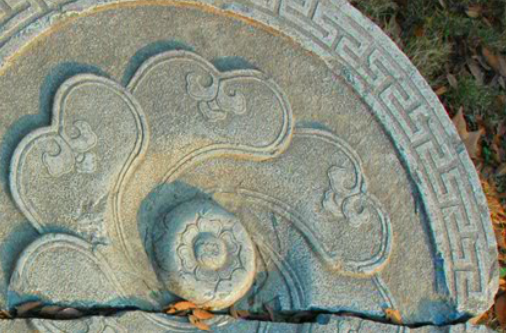
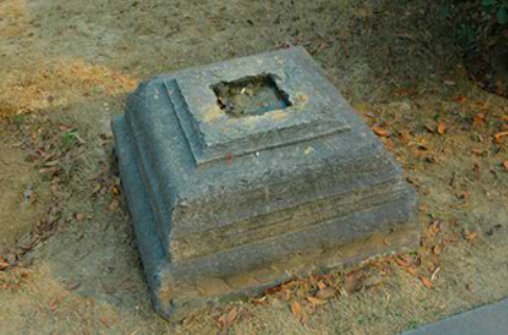
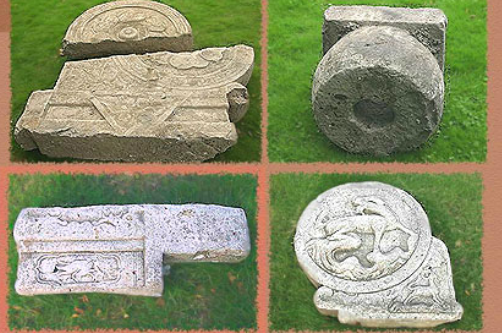
Stone Component in the late Qing Dynasty
In 1864, the Qing army occupied Tianjing, the capital of the Taiping Heavenly Kingdom, and burned the Palace. Zeng Guofan rebuilt the Office of Liangjiang Governor on the site of the Palace. These stone components were the remains of the reconstruction.
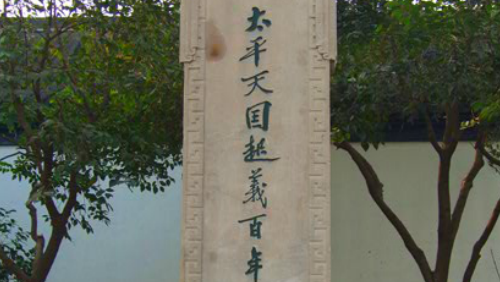
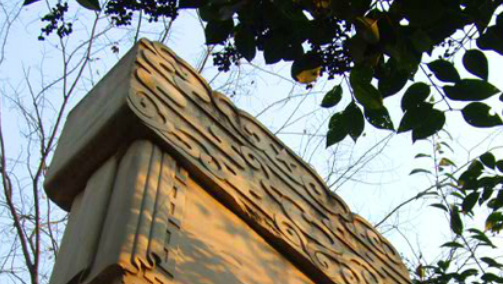
The Centennial Monument of the Taiping Heavenly Kingdom
In 1951, to commemorate the 100th anniversary of the Taiping Rebellion, the "Centennial Preparatory Meeting" of Nanjing decided to erect the monument, and recommended the main leaders of the CPC Central Committee write an inscription for the monument. Mao Zedong proposed that Guo Moruo, then vice president of the Government Administration Council, write the inscription.
The monument was made of white marble, with the fretwork featured by the character “万” on its body, cloud patterns on its top part, and patterns of great waves on its base, symbolizing uprising peasant movement surging forward with great momentum. There is a inscription at the back of the monument, written by the famous historian Luo Ergang of the Taiping Heavenly Kingdom, totaling 322 words.
On 31st August, 2002, due to the widening of Changjiang Road, the monument was removed from the front gate of the Presidential Palace. In December 2006, it was re-erected in Dong Yuan





